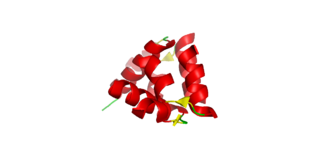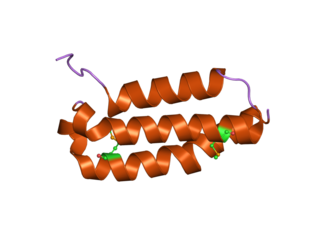Relaxin/insulin-like family peptide receptor 3, also known as RXFP3, is a human G-protein coupled receptor. [5]
Relaxin/insulin-like family peptide receptor 3, also known as RXFP3, is a human G-protein coupled receptor. [5]

Relaxin is a protein hormone of about 6000 Da, first described in 1926 by Frederick Hisaw.

Receptor activity modifying protein 1 is a protein that in humans is encoded by the RAMP1 gene.

Receptor activity modifying protein 2, also known as RAMP2, is a protein which in humans is encoded by the RAMP2 gene.

The neuromedin B receptor (NMBR), now known as BB1 is a G protein-coupled receptor whose endogenous ligand is neuromedin B. In humans, this protein is encoded by the NMBR gene.
The relaxin receptors are a subclass of four closely related G protein-coupled receptors (GPCR) that bind relaxin peptide hormones.

The prolactin-releasing peptide receptor (PrRPR) also known as G-protein coupled receptor 10 (GPR10) is a protein that in humans is encoded by the PRLHR gene.

The alpha-1B adrenergic receptor (α1B-adrenoreceptor), also known as ADRA1B, is an alpha-1 adrenergic receptor, and also denotes the human gene encoding it. The crystal structure of the α1B-adrenergic receptor has been determined in complex with the inverse agonist (+)-cyclazosin.

P2Y purinoceptor 14 is a protein that in humans is encoded by the P2RY14 gene.

Relaxin/insulin-like family peptide receptor 1, also known as RXFP1, is a human G protein coupled receptor that is one of the relaxin receptors. It is a rhodopsin-like GPCR which is unusual in this class as it contains a large extracellular binding and signalling domain. Some reports suggest that RXFP1 forms homodimers, however the most recent evidence indicates that relaxin binds a non-homodimer of RXFP1.

Relaxin/insulin-like family peptide receptor 4, also known as RXFP4, is a human G-protein coupled receptor.

G protein-coupled receptor 148, also known as GPR148, is a human orphan receptor from GPCR superfamily. It is expressed primarily in nervous system and testis. Is may be implicated in prostate cancer.

Relaxin/insulin-like family peptide receptor 2, also known as RXFP2, is a human G-protein coupled receptor.

Urocortin-2 is a protein that in humans is encoded by the UCN2 gene.

NPW is a gene that in humans encodes Neuropeptide W protein.

Prolactin-releasing peptide (PrRP) is a peptide hormone that in humans is encoded by the PRLH gene. PrRP stimulates prolactin (PRL) release and regulates the expression of prolactin through binding to the prolactin-releasing peptide receptor (GPR10).

Guanine nucleotide-binding protein subunit alpha-11 is a protein that in humans is encoded by the GNA11 gene. Together with GNAQ, it functions as a Gq alpha subunit.

RF(Arg-Phe)amide family 26 amino acid peptide, also known as P518, is a human protein.

GPR182 is a human gene which is an orphan G-protein coupled receptor.

Relaxin-3 is a neuropeptide that was discovered in 2001, and which is highly conserved in species ranging from flies, fish, rodents and humans. Relaxin-3 is a member and ancestral gene of the relaxin family of peptides, which includes the namesake hormone relaxin which mediates peripheral actions during pregnancy and which was found to relax the pelvic ligament in guinea pigs almost a century ago. The cognate receptor for relaxin-3 is the G-protein coupled receptor RXFP3, however relaxin-3 is pharmacologically able to also cross react with RXFP1 and RXFP3.

Relaxin family peptide hormones in humans are represented by seven members: three relaxin-like (RLN) and four insulin-like (INSL) peptides: RLN1, RLN2, RNL3, INSL3, INSL4, INSL5, INSL6. This subdivision into two classes is based primarily on early findings, and does not reflect the evolutionary origins or physiological differences between peptides. For example, it is known that the genes coding for RLN3 and INSL5 arose from one ancestral gene, and INSL3 shares origin with RLN2 and its multiple duplicates: RLN1, INSL4, INSL6.
This article incorporates text from the United States National Library of Medicine, which is in the public domain.